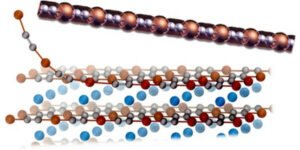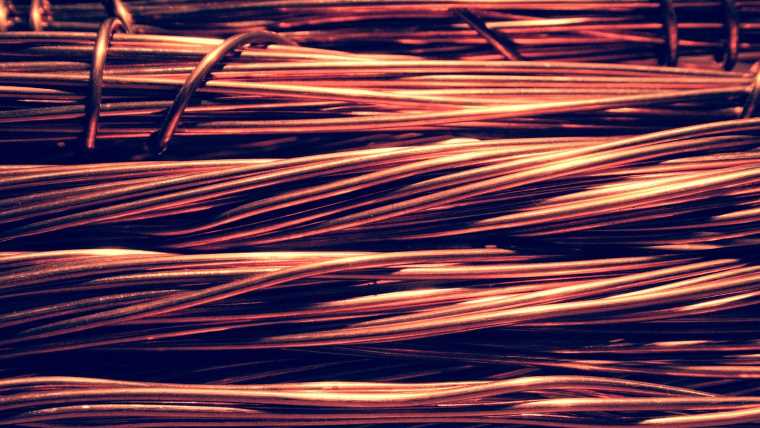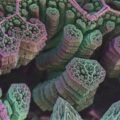Researchers from Switzerland’s École Polytechnique Fédérale de Lausanne (EPFL) that simulated thousands of possible one-dimensional materials say they have stumbled upon what may be the thinnest metallic wire ever discovered. One-dimensional materials like carbon nanotubes, which are built by stringing individual atoms together in a chain, are coveted for their unique and often unusual electrical, magnetic, and optical properties.
The researchers behind this particular one-dimensional (1-D) material, which is assembled by alternating two carbon atoms and one copper atom, say their newly designed wire may be the thinnest metallic nanowire ever created that can also remain stable at 0 degrees Kelvin. If the simulated wire can be fabricated, the researchers believe it could find numerous applications in future downscaled electronic components.
Computer Simulations Identify Top Candidates to Grow One-Dimensional Materials
To start, Chiara Cignarella, the lead author on the paper outlining the discovery, and colleagues Davide Campi and Nicola Marzari wondered if computer simulations using already known crystalline structures could help them find the perfect candidate without having to try to build thousands of them in a lab. Specifically, they were looking for three-dimensional crystals that had the right structural and electronic properties that would allow them to be easily “exfoliated.” According to the study authors, exfoliation is the process of ‘peeling away’ the excess material from the original 3D structure until only the one-dimensional string of atoms remains. Such a process has been used in the past to extract two-dimensional (2-D) materials like graphene from three-dimensional ones, but the researchers note that this would be the first time it has been used to exfoliate one-dimensional materials like carbon nanotubes.
This conceptual approach, which was born at the EPFL’s Laboratory for Theory and Simulation of Materials, part of the National Centre of Competence in Research (NCCR) MARVEL effort, led to the creation of a database of over 780,000 known three-dimensional crystalline structures cobbled together from a number of different scientific databases from around the world. During this process, the researchers say they focused specifically on crystals held together by van der Waals forces. According to the press release announcing the discovery, van der Waals forces are “the sort of weak interactions that happen when atoms are close enough for their electrons to overlap.”
Next, the team created a specialized algorithm to sort through the massive amount of data they had compiled. If it worked correctly, their algorithm would identify crystals whose spatial organization of atoms contained natural wire-like threads. It would also calculate precisely how much energy would be required to separate these one-dimensional nanowires from the rest of the baseline crystal, which is critical in determining how viable they would be to actually fabricate.
“We were looking specifically for metallic wires, which are supposed to be difficult to find because 1-D metals, in principle, should not [be] sufficiently stable to allow for exfoliation”, Cignarella explained. For example, the researchers say that once-promising one-dimensional carbon nanotubes have fallen out of favor since they have proven “very difficult to manufacture and control.”
From 780,000 Candidates to Four
This effort initially parsed the massive list of potential crystals down to just 800 viable candidates. Some more refining based on the simulated stability, electronic, and structural properties of this list narrowed it even further to the top 14 and then ultimately to the four most promising candidates. Notably, two of those materials were metals, and the other two were semi-metals.
Ultimately, the algorithm’s most intriguing candidate was a straight-line chain composed of two carbon atoms and one copper atom. Dubbed metallic wire CuC2, simulations of the one-dimensional material showed the conductive electronic properties of a wire while also remaining stable at a normal operating temperature. That’s because this particular simulated chain was also resistant to distortion from “Peierl distortions,” which are breaks in the one-dimensional string.


“It’s really interesting because you would not expect an actual wire of atoms along a single line to be stable in the metallic phase,” Cignarella said of their top candidate.
The researchers say they were also pleased to discover that their theoretical one-dimensional wire could be exfoliated from three distinct crystal sources. According to their study, they are NaCuC2, KCuC2 and RbCuC2.
“It requires little energy to be extracted from them,” the release explains, “and its chain can be [bent] while preserving its metallic properties, which would make it interesting for flexible electronics.”
Fabricating Top Materials to Understand Their Real-World Performance
In their study, published in the journal ACS Nano, the researchers note that their algorithm also discovered some other promising one-dimensional materials. For example, one semi-metal identified by their simulations, Sb2Te2, could help physicists study excitonic insulators. An exotic state of matter that was initially theorized over 50 years ago, excitonic insulators have never been observed directly. If fabricated in real life, Sb2Te2 might allow this quantum phenomenon to become visible at macroscopic scales.
Next, Cignarella says his team hopes to partner with experimentalists who could synthesize these one-dimensional materials, including their copper carbon nanowire. In theory, creating these materials in the real world could allow scientists to test how they transport electric charges and how different temperatures affect their stability and performance.
According to the study authors, “both things will be fundamental to understand how they would perform in real-world applications.”
Christopher Plain is a Science Fiction and Fantasy novelist and Head Science Writer at The Debrief. Follow and connect with him on X, learn about his books at plainfiction.com, or email him directly at christopher@thedebrief.org.

